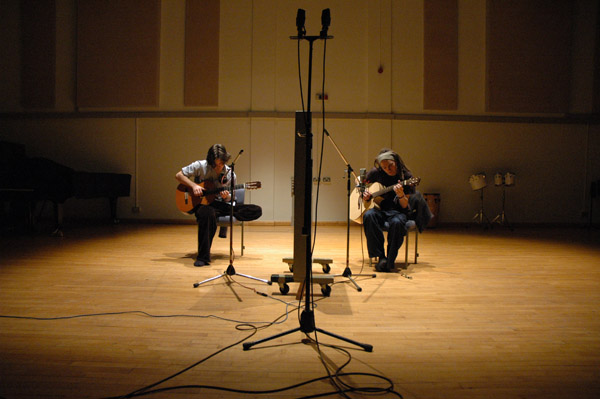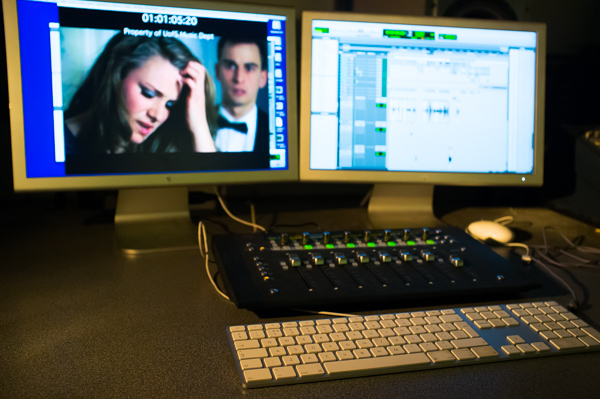IoSR Blog : 24 May 2013
What should Studio 3 be for?
Whilst planning to revamp Studio 3, we've been thinking again about what we want to be able to do in there. We want to use this refurbishment as an opportunity to do even more exciting things, and plan the equipment and installation accordingly.
Studio 3's main use for the foreseeable future is still likely to be an overdub and mix room for music recording. That's still the core of the Tonmeister course, and being able to mix music in Studio 3 reduces the load on Studios 1 and 2, that are always heavily in demand. This inevitably means music-oriented software and equipment, of the kind that is used in industry, so that students are prepared for work after graduation. It also means finding something that will work with our 24-track Studer A80 analogue tape machine: they're still used in industry so we still want our students to experience working with them.

Increasingly, our graduates are finding employment in television, film, or post-production: there are many jobs in the area of audio for video. Based on this, we've introduced new post-production teaching and coursework into the Tonmeister course. So ideally Studio 3 should be able to cater for this, and again be representative of the kind of equipment and software that is used in this industry.

Our other main consideration is that Studio 3 is used for research. A major strand of our research is spatial audio, and with the purchase of the loudspeaker sphere, we're going well beyond 5.1, including speakers above and below the horizontal plane. So it would be useful to be able to mix and spatially manipulate sound with greater flexibility than 5.1. It will also set us up for mixing to new and upcoming cinema audio formats.

How is the room currently used?
The room is usually used by students to mix things recorded elsewhere. As students mostly are still learning their craft, it typically involves making a first mix, taking it elsewhere to listen to it, realising that … erm … well, let's say "it needs more work", and then going back into the studio for another go. For this, instant recall of mixes with automation is very useful.
It's also sometimes used to record new material, either additional tracks from the overdub booth, or from the other studios via the tie lines. For this, a number of microphone inputs are necessary, perhaps up to 12 for overdubs or potentially more for large multi-studio sessions.
We've also started holding mixing workshops, where our associate lecturers give feedback and show how to make improvements to students' mixes. This works best if the associates can recall a student's mix and physically make changes, which can then be saved so the student can look at in detail later. For this, again, instant recall of mixes with automation is be very useful.
What new things might you want to do in there?
Increasingly, students buy their own small DAW-based systems. They don't have to, as we provide all the equipment necessary to complete the course. Nevertheless, the ability to sit at home all night and tweak things is appealing to many. The downside to this is that unless you're very experienced and know your system and its limitations intimately, the chances are that it isn't going to be as good as if mixed in a properly acoustically treated space with high quality monitors and using real faders.
We've tried to encourage students back out of their bedrooms by putting Euphonix / Avid fader controllers in the edit rooms. It would be nice to take this one step further by having something that can act as a bigger and better DAW controller.

As part of the course, we also have a lot of listening sessions. After all, being able to listen is one of the most important skills of an audio engineer. These sessions range from ear training (learning to spot and identify problems, and increasing students' sensitivity to audio artefacts), to listening to recordings (both commercial and student work) and critiquing these, usually with input from our highly experienced tutors, associate staff, and visiting speakers.
At the moment, these take place in Studio 2 floor. It would be great if we could rearrange Studio 3 to accommodate these: it would free up time in Studio 2, and would allow more flexibility to use any processing or outboard in the studio, or to audition work in progress.
We could also use this as an opportunity to introduce a wider range of work to the course. For instance, at the moment there isn't a requirement to do surround recording and mixing. Perhaps with new facilities in Studio 3 this will be possible. Also, new facilities may enable a wider range of work in audio for video, such as mixing larger film or television projects.
So is a console really necessary for all that?
That's a very good question. We've been planning this refit for a few years, and have taken time to talk to as many people involved in various industries as we could. If we were a commercial music studio, we'd be persuaded by the argument of not buying a console and instead buying a simpler DAW controller and lots of shiny outboard processing units. It's increasingly the way things are going in the industry, and in one particular example from our research, one of our Grammy award-winning graduates was using an expensive analogue console in a well-known studio simply as a table for the keyboard and mouse.
On the other hand, there are plenty of examples where a console (or at least a sophisticated DAW controller) is still necessary: live broadcast, or film and television music scoring and dubbing, for example. Also, we aim for our students to be able to work in the leading studios in the world (and looking at the number of our graduates at the likes of Abbey Road, Air, and Real World studios, we do a pretty good job of it). To be able to do this effectively, they need to know how to use the kind of large consoles that are found in these places.
Finally, we feel that we should provide things for students that they're unlikely to be able to afford for themselves. We're aware that going to University is very expensive these days (when I'm world dictator I'll change this, but until then ...). For the price of a year's fees you could set yourself up with a decent computer, DAW, interface and plugins, so we feel that we should be able to offer something significantly beyond this (ignoring, for now, the excellent teaching, of course!). From an educational point of view, having solely a DAW and simple controller in Studio 3, even with a large amount of outboard and expensive interfaces, doesn't offer anywhere near as much as a console. And if the console also acts as a DAW controller, we've got that aspect covered anyway.
Essentially, you're after the impossible then?
Unfortunately, it seems that way. We want a console that:
- is a fantastic music console
- is a fantastic film/TV dubbing console
- is a fantastic DAW controller
- has very flexible surround sound panning
- is representative of commonly used music consoles
- is representative of commonly used dubbing consoles
- can interface with the Studer A80 24-track
- and can instantly recall snapshots and mixes
So what meets the bill? Well, that's probably another blog post.
by Russell Mason
